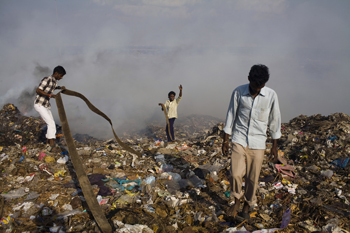| << Upcoming Exhibitions
<< Exhibitions Archive
<< 2011
|
Global Health in Focus: David Rochkind

David Rochkind, Landfill.
Workers at a local garbage dump, who scavenge for trash that they can sell, try to put out a fire so they can continue working. Local NGOs say that there is a huge problem with TB among the workers in the dumping ground, as well as the families that live near it, owing it poor nutrition and hygiene, which can make them more susceptible to developing active TB.
<< back to Global Health in Focus
Bio
Rochkind generally focuses on how social conflict and health issues affect and change the communities where they exist. His major projects have included work on Hugo Chavez’s self-styled Bolivarian Revolution; the Western hemisphere’s most polluted town, La Oroya, Peru; the global tuberculosis epidemic; and Mexico’s drug war.
Rochkind’s work has been published in numerous media outlets, including The New York Times, Stern, Le Monde Magazine, Rolling Stone, Time, Newsweek, and others. He has also done work for a variety of development agencies, including CARE, UNHCR and The Carter Center. He was named one of PDN’s “30 New and Emerging Photographers to Watch,” and he has won awards from the National Press Photographers Association, the Magenta Foundation, the World Health Organization, and the Santa Fe Center Project Competition, among others. His work has been exhibited in the United States and abroad at the Museum of Contemporary Photography (Chicago, IL); Rubin Center for the Visual Arts (El Paso, TX); the Woodrow Wilson International Center for Scholars (Washington, DC); and many others.
For the past three years, Rochkind has worked on projects about the global tuberculosis epidemic with the support of Johns Hopkins University, the World Health Organization and the Pulitzer Center on Crisis Reporting. Rochkind recently developed all of his photography and multimedia work into an interactive educational website and accompanying curriculum for use in high school classrooms. He recently presented this project at a US congressional briefing on tuberculosis and launched the website: www.tbepidemic.org.
Rochkind graduated from the University of Michigan with a BA in Sociology and speaks fluent Spanish.
Q & A with the Artist
1. Why and how did you decide to become a documentary photographer?
I began to take pictures as a way to explore issues that I was concerned about and then connect those issues to a wider audience in an emotional way. I think that we often lack a real emotional understanding of issues in the news, and I'm interested in using pictures to bridge the gap between intellectual and emotional understanding.
2. Why and how did you decide to focus on global health?
Health, and access to quality health care, is related to nearly every issue that we look at in developing communities. Good health is a necessary precursor to taking advantage of economic and educational opportunities, and damaged health almost always follows conflict and disaster. By looking at global health issues in a deep and complex way, we are forced to examine a host of other issues that are imperative to each community. I'm interested in global health because it serves as a vital first step to exploring the development of any community.
3. What is the main point/understanding that you'd like the viewer to get out of your work?
Public health issues are about more than incidence or mortality rates. Likewise, this work is more than just a visual representation of statistics. Health issues, especially in developing communities, do not follow the linear equation of simply diagnosing and treating the problem, and the varied lives of the subjects in this work represent the complex matrix of science, culture and development that influence treatment and prevention of disease. I want people to be able to engage with my work in a way that inspires dialogue about the problems, but also the complexity of the solutions.
4. What have you personally gained from your experiences and how have they influenced your subsequent work?
In all the projects I work on I am always amazed that people allow me into their lives to spend time with them, learn their stories and take their pictures. When I work on projects about public health, that process often happens when the subjects are at their most vulnerable and exposed, which consistently humbles me. They are open, kind and, very often, incredibly optimistic. I can only hope to have as strong a spirit, and be as graceful, as the people I have met and photographed.
5. What kind of responses has your work received from the health/science communities in the US?
This work has been broadly exposed to the health and science communities through exhibits, lectures and the educational website I created (www.tbepidemic.org). I think there is a real thirst for tools that can encourage dialogue about tuberculosis in complex ways that don't reduce the entire story to images of pain and death. People have been happy to see a project that creates a baseline of severity of TB, but expands on that to allow a broader audience access and exposure to the complicated issues that the disease presents.
|